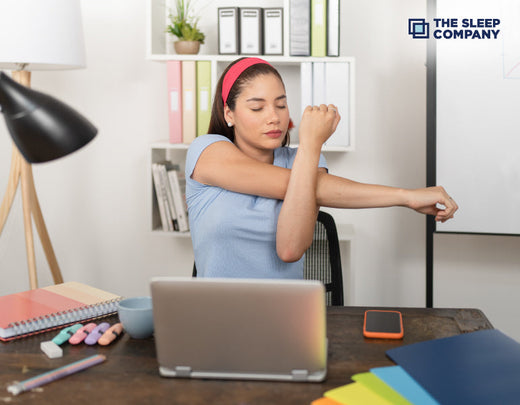My Cart

10 Exercises to Do While Sitting at a Desk in 2025

I have a desk, but I don't want to sit at it all day. - Richard Branson
As remote and hybrid work become the norm in 2025, maintaining our physical well-being during extended desk sessions is more important than ever. It’s time to face it; we spend a significant amount of time at our desks every day. On average, people spend around 7-9 hours a day at a desk (with breaks in between). This means we spend about 40% of our time sitting and working.
Whether you're working from home or in the corporate world, your body is undoubtedly sending you some subtle cues that it wants to move. Still, we deliberately avoid it and take it as a sign of “ productivity.”. But, in reality, various studies point out that employees who incorporate movement, including desk exercises, into their daily routine report 10-15% higher productivity levels compared to inactive workers.
Harvard Medical School research suggests that light desk exercises can reduce fatigue, with employees reporting a 65% decrease in feelings of tiredness when they engage in periodic movement during the workday. While we cannot avoid our tasks and hours of working, we can still use some time out of it and do some easy 15-minute desk exercises for our physical and mental well-being. Here are 10 simple desk exercises that you can try right away.
1. Desk Posture reset

The basis of desk wellness begins with good alignment. This is to combat the feeling of “I’ve been staring at screens too long."
How to do: Sit up straight with your feet flat on the floor, then slowly roll your shoulders back and down. Imagine a cord tugging the crown of your head towards the ceiling.
Duration: Hold this position for 10 seconds and take deep breaths.
Benefit: This exercise, advocated by current ergonomics specialists, helps to alleviate the symptoms of tech neck and encourages improved breathing patterns.
2. Chair Marches

Chair marches are a simple sitting exercise in which all you need to do is lift your knees up and down, just like you're marching while sitting.
How to do: Sit on the edge of your chair with a straight back and flat feet on the floor. Lift your knee towards your chest as high as possible, and then march in a motion alternating between legs.
Duration: For 1–2 minutes
Benefit: Chair marching exercises strengthen your hip flexors, improving blood flow. The most obvious advantage is the maintenance of mobility in joints and a slight decrease in lower limb stiffness.
3. Wrist and Finger Stretches

Our hands need more care than ever because of all the gesture-controlled devices and holographic computers we use.
How to do: Stretch your arms out in front of you and bend your wrists up and down slowly. Then, make a fist and then spread your fingers wide.
Duration: Do this 10 times.
Benefit: This keeps you from getting repetitive strain injuries, which are popular in modern jobs.
4. Seated Spinal Twist

How To Do: Sit with your back straight and feet flat on the floor. Place one hand on the knee across you and the other on the back of the chair. Turn your head and slowly twist your upper body to one side. Repeat this on the other side.
Duration: Hold for 10 to 15 seconds.
Benefit: This stretches the spine, eases back pain, and makes you more flexible. It's perfect for relieving pain from sitting for long periods.
5. Eye Focus Exercise

With the prevalence of AR glasses and high-resolution displays in 2025, eye strain has become a significant concern.
How to do: Practice the 20-20-20 rule: every 20 minutes, look at something 20 feet away for 20 seconds. Additionally, trace a figure-eight pattern with your eyes to exercise your eye muscles.
Duration: Hold for 20 seconds
Benefit:
6. Mindful Breathing

End your exercise routine with deep breathing exercises.
How to do: Inhale for four counts, hold for four, then exhale for four.
Duration: 1-2 min
Benefit: This practice not only oxygenates your muscles but also helps manage the increased stress levels common in our hyper-connected work environment.
7. Neck Rolls

Neck rolls at your desk are a quick and effective way to ease tension in your neck and shoulders, especially if you're sitting for long hours.
How to do: Sit upright and relax your shoulders. Slowly roll your head in a circular motion: move your chin to your chest, ear to shoulder, and back.
Duration: Perform 5-10 rolls in one direction, then reverse.
Benefit: Neck rolls help reduce tension and stiffness in your neck and shoulders, areas commonly affected by poor posture and prolonged computer use.
8. Desk Push-Ups

How to do: Place your hands on the edge of your desk, shoulder-width apart. Step back until your body forms a straight line from head to heels. Lower your chest towards the desk by bending your elbows, then push back up to the starting position.
Duration: Perform 10-15 repetitions.
Benefit: Desk push-ups engage your chest, shoulders, and triceps, providing an upper-body workout without leaving your workspace. They also improve core strength and posture.
9. Shoulder Shrugs

How to do: Sit with your back straight and arms relaxed by your sides. Lift your shoulders up towards your ears as high as you can. Hold for 2-3 seconds, then release and lower your shoulders back down.
Duration: Repeat 10-15 times.
Benefit: Shoulder shrugs are effective for relieving tension in your shoulders and upper back. They also promote better posture and reduce the risk of muscle strain.
10. Seated Toe Taps

The Seated Toe Taps exercise is a straightforward and efficient exercise that can be performed while seated at a desk to enhance circulation and engage the lower thighs.
How to do: Keep your heels on the ground and your toes off of it. For 30 to 60 seconds, quickly tap your toes up and down.
Duration: 2-3 times
Benefit: Toe taps keep your lower legs from getting stiff by increasing blood flow to them. People who tend to get varicose veins or swollen legs will benefit the most from this practice.
Conclusion
In 2025, staying active while working at a desk has never been more important. There are exercises you can do right at your desk to turn what would otherwise be a sedentary workday into an opportunity to improve your health and well-being. Along with these ten desk exercises, you can get The Sleep Company’s adjustable desk - Ergonomically designed to improve posture, reduce strain, and boost focus. Start adding such comfort products to your routine today and enjoy the benefits of a healthier, more active lifestyle.
FAQs
Yes, desk exercises can help improve your posture, reduce fatigue, and strengthen muscles even without getting up from your chair. Regularly practicing these exercises will contribute to better overall health and comfort.
It is advisable to do these exercises every 1-2 hours while sitting at your desk. Taking short breaks helps reduce the risk of stiffness and improves blood circulation.
Yes, many desk exercises are low-impact and can be done even when one has mild back pain. But if a person has chronic back pain or any other problem, it's best to talk to a health care professional before embarking on a new exercise program.
Absolutely! Office exercises help release tension, decrease stress, and improve concentration. They promote better circulation, leaving you feeling more energised and less fatigued.
Yes, they are ideal for working from home. In fact, since one does not have proper ergonomic furniture at home, these exercises become all the more essential to avoid pain and maintain flexibility.
Yes, they are designed to be discreet and can be done anywhere, even in the office, as long as it's either working from home or a corporate office. No extra equipment is needed; it can be done straight from your chair using a few minutes of focus.

































































